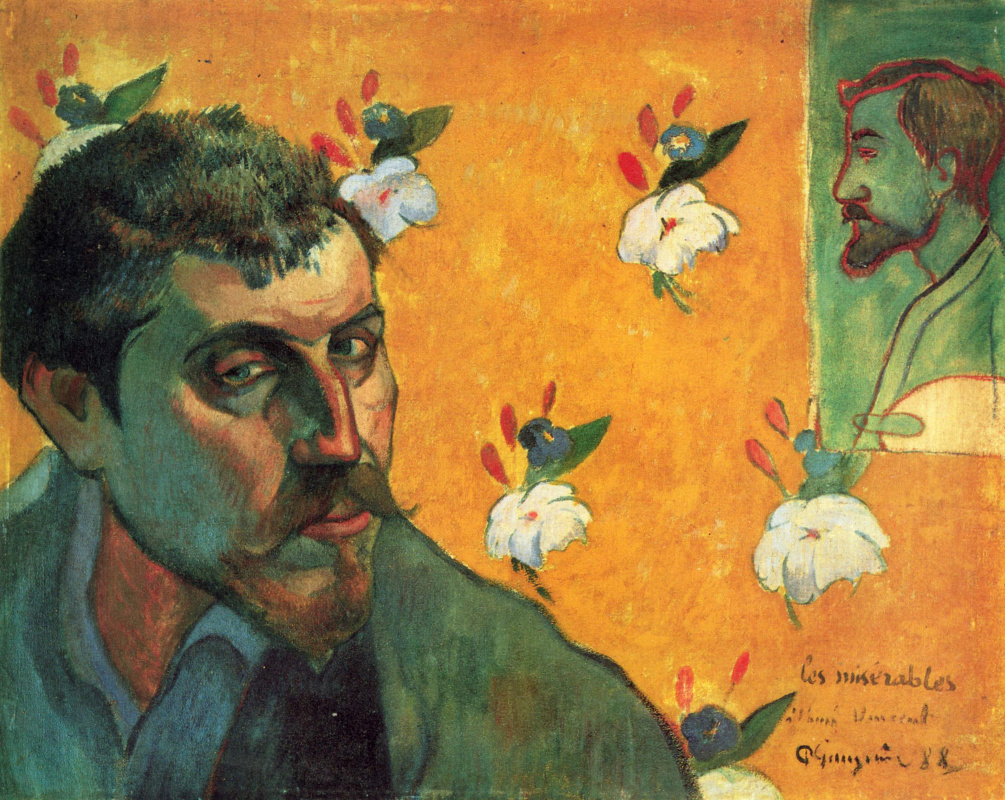log in
Enter site
Login to use Arthive functionality to the maximum
Self Portrait with Emil Bernard (Les Miserables)
Paul Gauguin • Painting, 1888, 45×55 cm
Description of the artwork «Self Portrait with Emil Bernard (Les Miserables)»
Self portrait dedicated Vincent van gogh, was written by Gauguin shortly before arriving in Arles and was part of a kind of competition game between artists. It began, however, even earlier, when Emil Bernardsent by van gogh own self portraitwith the image of Gauguin in the background.
Vincent, ignited by the idea of creating a colony of artists in Arles, dreamed of inviting here both Bernard and all his fellow artists, however, he decided to start with Gauguin. A lively correspondence ensued between them, during which Gauguin sent Van Gogh a self-portrait (depicting Bernard in the background) with a sly and questioning expression on his face, as if saying: “Are you capable of this?”
Van Gogh answered the challenge more than worthily. AT "Self-portrait dedicated to Paul Gauguin"he placed himself on the background of the same color that Gauguin used to portray Emile Bernard in his work. To reproduce such an exact shade - it is called "green" Veronese"- incredibly hard, but Van Gogh succeeded. Using the color and image of himself in the image of a Buddhist monk, Vincent allegedly made it clear to Gauguin that he was absolutely calm and ready to do everything possible to fulfill his dream. In addition, it seemed to him that Gauguin looked desperate on his self-portrait, and thus Van Gogh wanted to convey to his friend a piece of his own serenity.
The mood of Gauguin's self-portrait was completely different. He called it “Les Miserables,” referring us to the main character of Victor Hugo’s novel, Jean Valjean, a former convict and a man of complex fate. The artist liked to present himself as a passionate rebel who has no place in bourgeois society. To enhance this effect, Gauguin shifted his own face from the center of the picture to the left, going against all the picturesque traditions. In addition, he “illuminated” half of his face, and left half of his face in the shade, thus hinting at the duality of his nature.
Author: Evgenia Sidelnikova
Vincent, ignited by the idea of creating a colony of artists in Arles, dreamed of inviting here both Bernard and all his fellow artists, however, he decided to start with Gauguin. A lively correspondence ensued between them, during which Gauguin sent Van Gogh a self-portrait (depicting Bernard in the background) with a sly and questioning expression on his face, as if saying: “Are you capable of this?”
Van Gogh answered the challenge more than worthily. AT "Self-portrait dedicated to Paul Gauguin"he placed himself on the background of the same color that Gauguin used to portray Emile Bernard in his work. To reproduce such an exact shade - it is called "green" Veronese"- incredibly hard, but Van Gogh succeeded. Using the color and image of himself in the image of a Buddhist monk, Vincent allegedly made it clear to Gauguin that he was absolutely calm and ready to do everything possible to fulfill his dream. In addition, it seemed to him that Gauguin looked desperate on his self-portrait, and thus Van Gogh wanted to convey to his friend a piece of his own serenity.
The mood of Gauguin's self-portrait was completely different. He called it “Les Miserables,” referring us to the main character of Victor Hugo’s novel, Jean Valjean, a former convict and a man of complex fate. The artist liked to present himself as a passionate rebel who has no place in bourgeois society. To enhance this effect, Gauguin shifted his own face from the center of the picture to the left, going against all the picturesque traditions. In addition, he “illuminated” half of his face, and left half of his face in the shade, thus hinting at the duality of his nature.
Author: Evgenia Sidelnikova


